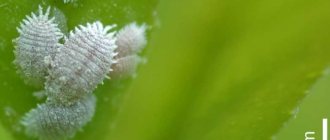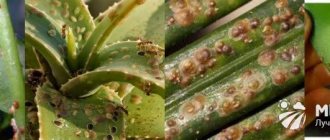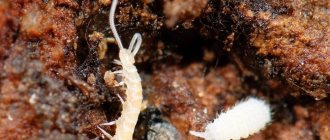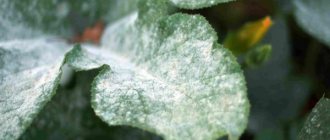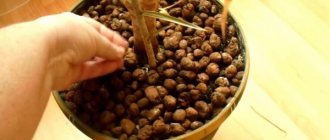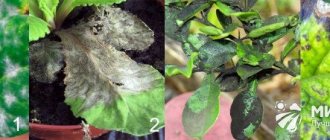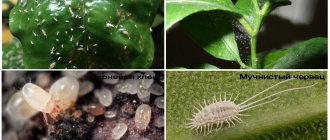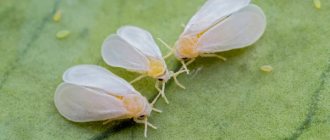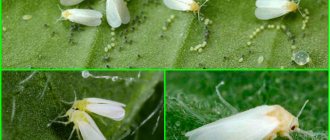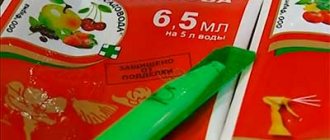Description of the pest
People also call it “furry lice” because of its appearance. They belong to the order of sucking insects . They are very difficult not to notice even with the naked eye. These suckers reach a length of up to 8 millimeters. The body of female scale insects is not fully developed and has an oval shape. But the males are already more similar to the insects we are familiar with: their body is not divided into sections, their limbs are well defined.
As adults, males do not feed because their mouthparts atrophy over time. But females and even larvae can easily make holes in leaves and buds, and then suck the juice out of them. This “function” of the mealybug poses the main danger to a healthy plant.
One of the difficulties in controlling hair lice is that they easily move from one plant to another . Details about what a mealybug is and how to deal with it are described in this article.
Why are mealybugs dangerous?
Mealybugs are tiny, white insects, about 3mm. in length, but their color and habit of grouping make them easy to spot on garden plants. They belong to aphids. Many (if not all) houseplants are susceptible to infestation, including: gardenias, begonias, chrysanthemums, ficus trees, English ivy and palms.
Any plant that has high nitrogen levels due to overfertilization will be especially attractive to pests.
Mealybugs feed by sucking sap from leaves, stems, roots, flowers and fruits. Damaged leaves appear wrinkled. In addition, insects can infect plants with mesh egg sacs and clusters of larvae.
Compounding the damage, the insect contains black sooty mold and promotes the growth of plant viruses.
Reasons for appearance
The main reasons are:
- Presence of larvae or eggs in the soil . Moreover, it could even be a substrate from the store. Therefore, it is important to disinfect the soil before planting. To do this, place the soil in the microwave for a few minutes or put it in the freezer overnight.
- Moving mealybugs from a new plant . To prevent this from happening, always quarantine the newly arrived plant in a separate room and monitor its condition for about a month.
- Improper care:
- cold room;
- watering with untreated water or water of the wrong temperature (both too warm and too cold have a bad effect);
- poor ventilation of the room;
- overly active introduction of nutritional complexes.
Popular preparations for indoor plants
"Akarin" (old name - "Agravertin")
It is considered a biological drug. This remedy enters the digestive organs of mealybugs and poisons them. After just eight hours, hairy lice lose their ability to consume food and die 24 hours after treatment .
How to use? To prepare the solution, take one liter of purified water, add two drops of “Akarin” to it (you can do 5, then the concentration will be higher). The sheet plates are wiped on both sides with a cloth soaked in the composition.
It is allowed to apply twice per season, but at the same time maintaining an interval of 15-20 days.
Advantages:
- is not addictive;
- harmless to bird earthworms;
- can be combined with insecticides and pesticides.
Disadvantages: bees can be poisoned by this solution.
Price: 13-20 rubles.
"Aktara"
It acts in much the same way as the previous drug: it enters the digestive system of pests and atrophies all organs .
But it works faster – within half an hour. How to use? You can spray the affected plants (the protective barrier will remain for up to four weeks). For spraying, 1-2 grams of Aktara are poured into ten liters of water. For irrigation (in this case, the protection will last up to 60 days), use 8 grams of the drug for the same amount of water.
Advantages:
- has high efficiency indicators;
- can be used in conjunction with pesticides;
- non-toxic to earthworms and birds.
Flaws:
- causes addiction in scale insects;
- poses a danger to bees.
Price: 25-30 rubles.
"Aktellik"
This drug is chosen only as a last resort, when nothing takes away the hairy lice.
How to use? Dilute the ampoule (its volume is two milliliters) in one liter of water. Spray the plant with the resulting solution. The result is expected three days after the procedure . You can repeat the treatment no more than two or three times. After this, the plant should rest for two to three weeks.
Advantages: powerful drug.
Disadvantages: “Actellik” is a chemical product, so treatment with it can only be carried out outdoors. But even under this condition, pregnant women and people with asthma are prohibited from using the product.
Price: 6-10 rubles.
"Bankol"
This drug paralyzes not only the digestive system, which is why the bugs cannot feed, but also the central nervous system, after which the pests stop moving. After a couple of days, the “lice” die .
How to use? Place 1 gram of the product in two liters of water and spray the plant with the resulting composition. It will be necessary to carry out two such treatments, maintaining an interval of 10-15 days between them.
Advantages:
- high efficiency indicators;
- there is no pungent odor and no negative effect on the mucous membranes of the eyes;
- is not washed away by precipitation if it begins two hours after treatment;
- dissolves well in water.
Disadvantages: toxicity of the drug is present, albeit at a low level.
Price: 10-12 rubles.
"Vertimek"
The drug is of natural origin. It affects the central nervous system of parasites and paralyzes them. Death occurs within three days after treatment .
How to use? Dilute the product according to the instructions on the package. Spray the affected plant with it, then cover it with plastic wrap and leave it like that for 24 hours.
Advantages:
- actively fights parasites even in hard-to-reach places;
- destroys pests in a minimum number of applications;
- does not leave marks on the surface of sheet plates.
Disadvantages: high toxicity for humans (in the scientific community - 2nd class).
Price: for a 250 ml bottle you will have to pay about 2000 rubles.
"Inta-vir"
The product affects insects by paralyzing them, causing spasms and convulsions throughout the body.
After these actions, the “hairy lice” die. How to use? One tablet is dissolved in 5-10 liters of clean water (the volume of liquid depends on the desired concentration). You can spray affected plants to save them and healthy ones to prevent pest attacks. It is important to use the prepared solution immediately . After the mixture sits, it will no longer be suitable for use. The procedure can be repeated no more than three times and at intervals of two weeks.
Advantages: the drug is highly concentrated and fast-acting.
Disadvantages: toxic to humans.
Price: a sachet with 8 grams of the drug costs 10 rubles.
"Karbofos"
How to use?
The drug is sold in various forms: concentrated emulsion, powder, concentrates in ampoules, ready-made diluted drug. The diluted product should be used immediately. The resulting emulsion is sprayed onto the plants. Advantages: The active chemical disintegrates within ten days.
Flaws:
- acrid chemical smell;
- high concentration of chemicals.
Price: the cost of the product depends on its volume:
- 30 grams of powder – about 40 rubles;
- 60 grams of powder - 60 rubles;
- 1000 ml of emulsion – about 150 rubles;
- packaging of ampoules - about 30 rubles.
"Confidor extra"
It acts on parasites in two ways:
- Destroys them by getting on the skin of mealybugs.
- The rest are destroyed when they eat poisoned leaves and flowers.
How to use? One package, weighing one gram, is diluted in 10 liters of water. (This solution is enough to spray a huge number of plants, so try to proportionally reduce the amount of the drug and the volume of liquid). You will see the full result in 48 hours.
Advantages:
- not only actively fights pests, but also restores damaged plants;
- the first results will become noticeable within a couple of hours;
- destroys even the smallest insects that are difficult to notice with the naked eye.
Disadvantages: chemical composition of the drug.
Price: 35-40 rubles.
"Tanrek"
This drug is aimed at combating aphids and whiteflies. But to destroy mealybugs, the concentration of the drug is rather weak, so to completely defeat the pest, you will have to use “Tanrek” several times .
How to use? You need to dilute 0.3-1 ml of the drug in one liter of water and spray the affected plants with the solution.
Advantages:
- suitable for controlling many pests;
- without smell;
- can be used at any temperature.
Disadvantages: weakly fights mealybugs.
Price: from 55-60 rubles.
"Fitoverm"
One of the few drugs of a biological nature.
How to use? Dissolve two milliliters of the drug in 500 ml of water. It is not advisable to spray during daylight hours, since the active substances decompose in the light. To completely destroy mealybugs, 3-4 treatments are necessary .
Advantages:
- is not addictive;
- within a day it completely decomposes in the soil;
- non-toxic.
Flaws:
- the need for several procedures to obtain a full result;
- It is not advisable to combine with other insecticides.
Price: from 10 rubles.
You will find additional information on how to deal with mealybugs on indoor plants, as well as the reasons for their appearance and prevention, in a separate material.
How to deal with mealybugs on indoor plants?
Pests on indoor plants give us unpleasant emotions. And we want you to be joyful and cheerful - so look at our tips.
Experts recommend comprehensive control of mealybugs on indoor plants. If the flower is slightly damaged, it is not difficult to fight the pest and you can try using folk remedies, but if the damage is severe, it is better to use drugs.
In any case, to get rid of mealybugs you need to carefully follow the recommendations of specialists and experienced gardeners.
COMBAT MEASURES
- Remove affected leaves or shoots when the pest is detected. If trimming is not possible, then remove all the scale insects with a cotton swab dipped in soapy water.
- Move the affected plant to a separate place, and carefully inspect the rest. Wash the area near the affected flower (window sill, window, outer sides of pots) with soapy water and then with insecticide.
- Replace the top layer of substrate.
- Using a cotton swab, cloth or soft toothbrush, wash the plant with a solution of water and methyl alcohol (1:1), soap solution or tobacco infusion to wash away small mealybugs.
- Rinse off the solution and leave the plant to dry. After the water has evaporated from the leaves, spray the plant and top layer of soil with an insecticide or folk remedy.
- Cover the flower with a bag for 20-30 minutes and rinse it in the shower to wash off the drug and the dead mealybug. If you treated it with a systemic insecticide (Aktara, etc.), then there is no need to wash it off.
- In between treating the plant, wash it every day with water and clean it of parasites.
ADVIСE. Types of plants whose leaves cannot be washed must be sprayed, preferably with preparations.
If the root system is damaged by the pest, carefully wash the roots and trim off the damaged areas, and then transplant the plant into a new substrate.
Treating mealybugs is often a fairly long process that can take 6-12 months.
.
Mealybug close up
.
Prevention of insect development
In order to avoid poisoning yourself and plants with chemicals in the future, it is better to prevent the development of harmful insects. To do this you should:
regularly inspect the plant;- replant flowers in time, renew the soil in pots;
- follow all recommendations for the care of each specific flower;
- promptly remove dried parts of the plant;
- disinfect the soil before planting;
- Quarantine new flowers.
We all want our home to have a lot of greenery, and for this greenery to be healthy and blooming. But this requires effort. Today we described in detail how to deal with one of the types of pests (what other types of scale insects are there and how to deal with them?). This information should help you in properly caring for your plant. And for conscientious care, the plants will definitely reward us with clean air in the house.
Causes and signs of appearance
The reasons for the appearance of the parasite are violations in crop care, improper metabolism, and excessive application of nitrogen to the soil. A scale insect can get into your home if it lives on an ornamental plant purchased in a store. It is able to penetrate indoor soil where there are infected seedlings. For active reproduction, parasites require high humidity and a temperature of 25 degrees Celsius.
You can suspect the presence of insects on your favorite flowers by the characteristic nectar, which is located in drops. On buds, stems, foliage, and near the roots, nests similar to the well-known cobwebs or lumps of cotton wool appear. When transplanting, you can actually see white threads in the root system that prevent nutrients from being absorbed. If plants are damaged, their growth slows down, the stem changes shape, the leaves lose chlorophyll, become deformed, and rotting of the roots is observed. All this is not beneficial to the appearance and health of your crops.
How to use Aktara insecticide for orchids
In search of effective drugs against mealybugs and other orchid pests, flower growers turn to a wide variety of means. One of the best results comes from using the insecticide Aktara.” In order for this drug to be as effective as possible, you must carefully study the instructions and recommendations for its use - they are given in the following article.
Application of Aktara for orchids - rules and recommendations
Many gardeners use Aktara to treat orchids - this insecticide belongs to the group of neonicotinoids, has a broad spectrum of action, and helps destroy many parasites at all stages of growth and development. This drug is used for the prevention and treatment of damaged flowers.
Application of Aktara for orchids - rules and recommendations
Description of the drug (composition, principle of action)
Aktara is an insecticidal drug of chemical origin belonging to the group of neonicotinoids. Externally, it is a water-soluble brownish granule or a transparent yellow liquid without a noticeable odor. Available in bags of different sizes, ampoules, bottles and canisters. Manufacturer: Swiss.
There may be counterfeits of Aktara on sale that do not correspond to the declared characteristics. Before purchasing the drug, you should carefully study the packaging and documentation for the product available from the seller.
The main active ingredient in Aktara is thiamethoxam, a powerful nerve poison that has a destructive effect on pests within several hours after use.
The principle of action of the insecticide is as follows:
- the poison penetrates plant tissue and spreads throughout it along with cell sap;
- the insect, feeding on plant sap, also absorbs the toxic components of the drug;
- the poison causes intestinal upset and paralysis of the internal organs of the insect, as a result of which it stops feeding and dies within 24 hours after contact with the insecticide.
The process of decomposition of the active component takes quite a long time, so the protective effect of Aktara on plants lasts about 3-4 weeks, and if the drug is applied by soil, the effect of its use is noticeable for almost 2 months.
Analogs
The drug can be used for prevention
According to the stated characteristics of the manufacturer, this drug has no analogues that could replace it in terms of quality and effectiveness.
Nevertheless, there are several similar drugs, the active components of which destroy orchid pests.
Tiara
The composition includes the active substance - thiamethoxam, but the effect of this drug is not similar to the medicinal properties of Aktara.
Price - 3200 rub. for 1 l.
Cruiser
It has long-lasting protective properties and is more suitable for treating seeds and soil-based plants. When irrigating orchids, it instantly penetrates into the cells of all organs. It affects the nervous system of parasites that love to feast on the juice of flowers.
The cost for one 5 liter bottle is 2500 rubles.
Advantages and disadvantages
Before using Aktar against pests that pose a danger to orchids, you should carefully study the positive and negative characteristics of the insecticide. They are as follows.
- high efficiency against a wide range of dangerous insects;
- minimal phytotoxicity;
- resistance of the active component of the drug to elevated air temperatures;
- ensuring a long-term protective effect;
- ability to quickly penetrate plant tissues;
- efficiency and affordable price.
- it is likely that individual pests will become accustomed to the active substance and, as a result, a decrease in the effectiveness of the drug with long-term use (alternation with other drugs of similar action makes sense);
- low effectiveness against ticks;
- toxicity to humans and animals;
- when preparing working solutions in small volumes, it is necessary to very accurately measure the dose of the drug.
An important characteristic of the drug in relation to orchids is its resistance to washing off. Treated flowers can be bathed and sprayed within a few hours after treatment - this will not reduce the effectiveness of the insecticide.
Folk remedies: soap-alcohol solution
A soap-alcohol solution is a frequently used folk remedy to combat mealybugs.
A teaspoon of crushed laundry soap is dissolved in water, then the amount of solution is increased to a liter. Add a tablespoon of alcohol or two tablespoons of vodka.
The plant is sprayed, while the soil underneath is protected with film or a piece of cellophane.
The next day, the soap must be washed off with clean water. Treatments are carried out at intervals of three days until the scale insects completely disappear.
Advantages:
- cheapness;
- effectiveness in case of minor plant infestation by pests;
- safety for humans and animals.
Flaws:
- the product does not help with large numbers of scale insects;
- Frequent processing required;
- inconvenient to use on outdoor plants (due to the size of the latter or the threat of rain).
List of orchid pests sensitive to Aktara
One of the advantages of Aktara is its wide spectrum of action and effectiveness against a large number of insects that are dangerous to orchids and other plants. According to the manufacturer’s official regulations, the insecticide can be used to protect flowers from the following pests:
- soil flies;
- thrips;
- whiteflies;
- aphids;
- fungus gnats;
- scale insects and false scale insects.
In fact, the list of pests sensitive to Aktara components is much wider. Thus, flower growers successfully use the insecticide in the fight against mealybugs, insects that are especially dangerous for orchids.
Aktara has no effect on representatives of the Ticks squad. When orchids are infected with spider mites, the plants should be treated with a suitable insectoacaricidal preparation.
Use of insecticides
The use of insecticidal preparations for mealybugs is recommended in cases where there are a lot of parasites or folk remedies have proven ineffective. They will have to be applied twice with an interval of 10-15 days. This is necessary in order to destroy the larvae that emerge from the eggs.
- "Confidor". A systemic insecticide that copes well with pests of indoor plants when other drugs have not brought a positive result. Moreover, its effectiveness is at the proper level even in cases where the parasite has settled in the rhizome. Has intestinal contact activity. The working solution, which is prepared from 1 g of the drug and 10 liters of water, is sprayed on the above-ground parts of the infected specimens and the soil is additionally shed. If the infection is serious, then the working solution is made more concentrated - 1 g of the drug per 5 liters of water.
- "Aktara" is a complex drug that helps get rid of a wide range of pests, including mealybugs. Shows high efficiency both when sprayed and when added to the substrate. Half an hour after treatment, the parasites lose their ability to feed and die within 24 hours. This product is compatible with many insecticides, fungicides and growth regulators. How to dilute the drug "Aktara" against mealybugs: at a concentration of 250 g/kg - 1 g of product per 10 liters of water; at a concentration of 240 g/l - 1 ml of product per 10 liters of water. The prepared working solution is poured onto the soil under the infected plants.
- "Aplaud." An insecticide that comes in the form of a wetting powder. Characterized by contact-intestinal activity. The main active ingredient is buprofezin, which interferes with the normal synthesis of the chitinous cover of the pest, which is why the larvae do not molt. As a result, they die. The working solution is prepared from 1 g of the drug and a liter of water. The components must be carefully moved and used to treat plants. Effectiveness does not appear immediately - the death of parasites is noted within a week. It can be used together with synthetic pyrethroids and organophosphates, and does not cause resistance in pests.
- “Fitoferm” is a biological preparation that perfectly protects plants from mealybugs. It is based on the waste products of soil microorganisms and exhibits an intestinal contact effect. Penetrating into the pest’s body, the active components of the product affect its digestive system, as a result of which it gradually loses its ability to feed and dies. The drug exhibits activity within one to three weeks from the moment of treatment.
- "Mospilan" is a systemic insecticide that exhibits contact-intestinal activity. Based on acetamiprid. Once on the leaves and stems of the plant, the active substances are immediately absorbed and evenly distributed throughout the plant’s body. Thanks to this ability, even those areas that have not been properly treated receive protection. Parasites die upon contact with the toxic substance and when sucking out the juices of the treated plant. The result of the drug can be observed within an hour after spraying: the parasites experience a lack of coordination of movements, as a result of which they lose the ability to stay on the underside of the leaves.
Important! When using the drug "Mospilan", the plants must be placed in the shade, since if they are exposed to sunlight, burns may occur!
It is advisable to re-treat mealybugs with a drug based on a different active ingredient, since the pest may develop resistance - resistance to the poison.
Important! The organophosphorus insectoacaricide "Actellik" can be used to treat indoor plants only if they are located outdoors. The use of this product in a residential area due to its high toxicity is strictly prohibited!
Dosage and procedure for preparing the solution
For orchids, it is allowed to use both liquid and granular forms of Aktara. The granules (in the required dosage) are first poured with a small amount of water to allow them to completely dissolve. After this, the volume of the solution is adjusted to the calculated volume by adding clean water to it. The required dose of the liquid drug is immediately diluted in the recommended volume of water.
The standard dosage of insecticide against pests such as aphids, whiteflies, thrips, soil flies and fungus gnats is 1 g of granules per 10 liters of water. The drug purchased in liquid form must be diluted at the rate of 1 ml per 10 liters of water. Aktar's medicinal solution for orchids against mealybugs is prepared from 8 g of granules and 10 liters of water. It should be taken into account that for indoor floriculture such volumes of solutions are very large, because 10 liters of suspension is enough to treat at least 250 pots of orchids.
The finished working fluid cannot be stored, and draining its remains into sewer systems is also prohibited, so it is useful for lovers of orchids and other indoor plants to have special scales at home for measuring ultra-small doses of fertilizer preparations. Using such a device, you can use a tenth of the standard dosage of Aktara (that is, 0.1 g or 0.8 g of insecticide) to prepare a solution and dilute this amount in 1 liter of water. This volume of suspension is enough to treat 6-8 orchids.
Houseplants are dying - the cause is mealybugs!
Mealybugs are very nasty pests.
They attack indoor flowers. As a result, they develop poorly and have an unsightly appearance. These insects are popularly called “hairy lice” because of the large number of bristles and hairs on their oval body. The presence of the parasite reveals a white coating on the leaves. And the scale insects themselves are visible to the naked eye. You need to get rid of them immediately, because very soon they will spread to all the surrounding plants. Therefore, consider the following question: “If there are mealybugs on indoor plants, how to deal with them?” What is a mealybug?
The appearance of this pest cannot be confused with anything. This is a fairly large relative of the scale insect. The mealybug reaches up to 8 mm in length. Female “hairy lice” have an undeveloped oval-shaped body, more typical of insect larvae. They lay numerous eggs in special sacs in the axils of the leaves. The shoots on which the pest lives are covered with a white, sticky waxy coating. Males are not at all similar to females - they have wings and normally developed limbs, the body is divided into sections and ends in a bunch of tail filaments. With the help of their oral apparatus, females and larvae easily pierce the surface of a leaf, bud or shoot and suck out the juices from it. Young scale insects are extremely mobile and easily move between plants. Sexually mature males do not feed because their mouthparts atrophy as they grow older.
Signs of Mealybug Infestation
To detect pests, it is enough to carefully examine the indoor plant.
Main features:
- drooping look
– lethargy of leaves and shoots;
– underdeveloped buds,
– deformed leaves;
– white powdery coating with lumps;
– small “mosquitoes” (male scale insects) on the windows near the pots;
– the presence of sticky mucus (honey dew) on all parts of the plant;
– the presence of white inclusions in the earthen coma during transplantation;
– presence of white oval insects.
Any of these symptoms may indicate the appearance of a scale insect. Not a single flower is immune from infection. Special control should be given to citrus, amaryllis, cycad and palm plants, as well as cacti, violets and orchids. Often suffers from the azalea pest. The pest attacks young shoots. The leaves stop growing and begin to turn yellow. An azalea affected by insects loses its former appearance. Harm to the plant Mealybug literally pulls all the nutrients from the flowers, disrupting their growth and normal development. Sweet honeydew secreted by females provokes the development of associated fungal infections. Due to the sticky, impenetrable coating, the green pet's breathing becomes worse. This can cause the leaves to wilt and even fall off. Mealy aphids (another name for mealybugs) do not prefer a specific part of the plant, attacking everything that comes in its way. Not only shoots, buds and leaves are under attack, but also roots. If treatment is not started as soon as possible, the bug will spread to surrounding indoor plants. In time he will destroy them all. Therefore, it is necessary to immediately declare war if you notice mealybugs on indoor plants.
Causes of mealybugs
Why do these harmful insects appear?
There are several main reasons:
Presence of eggs and larvae in the soil.
Even purchased soil can be contaminated, so it is very important to treat it with hot steam before use.
Transfer of larvae with newly acquired plants. New pets should be kept separately and carefully examined periodically. You can place them next to other flowers only after finally making sure that there are no pests.
Errors in care - low room temperature, stagnation of moisture in the soil, insufficient lighting, excessive application of fertilizer. Improper care significantly reduces the plant’s immunity, causing various diseases.
The presence of dust on the leaves, irregular removal of dry parts. Untimely replacement of soil in pots. Harmful insects can live inside a compacted earthen clod.
Poor quality water for irrigation.
Measures to combat the mealybug
If white lumps are found, you need to wipe or wash the plant in a soap-alcohol solution (dissolve one teaspoon of finely chopped laundry soap in 1 liter of hot water, add 2 tablespoons of vodka), you can use a solution of dishwashing liquid. Rubbing the leaves with alcohol or vodka also helps. All these available means weaken the waxy coating of scale insects, which makes them more vulnerable to pesticides. Before treatment, all visible pests must be removed with a cotton swab or toothbrush. The cotton swab must be changed, and the brush must be thoroughly washed and treated with alcohol or detergent, so as not to transfer the bug to other parts or neighboring plants.
After the “mechanical” treatment, it is imperative to proceed to the “chemical” treatment. To do this, you can use insecticides: golden spark, fitoverm, actellik, phosphamide, intavir, fufan, metafos, actaru, karbofos, mospilan.
- actara for mealybugs: dissolve 4 g of the drug in 5 liters of water for watering and spraying;
- tanrek for mealybug: 1.5 ml per 5 liters of water for spraying or 1.5 ml per 2.5 liters of water for irrigation;
- Apache from mealybug: 1 sachet (0.5 g) per 2.5 liters of water for spraying or 1 g per 1 water for irrigation;
- Confidor for mealybugs: dilute 2 ml of the drug in 5 liters of water for spraying or 2 ml in 2.5 liters for watering;
In addition to spraying with the same solution, you need to spill the soil in the pot. Such treatments will have to be repeated more than once; it is best to change the drug each time. It is assumed that the bug very quickly gets used to one drug and develops immunity. It should also be noted that it is difficult to fight the scale due to its waxy coating. If you simply, upon discovering a bug on a plant, immediately treat it with an insecticide, you will not always be able to achieve the desired result. The insects or their larvae (egg sacs) need to be disturbed - with a stick, brush, cotton wool, and their protection - the wax shell - is weakened, only then the insecticide can act on them. This complex treatment is carried out every 4-5 days. With less frequent processing, no measures help.
The fight against scale insects is not quick and lasts up to six months.
If damaged by root worms, the soil is completely changed. The pots are thoroughly washed in hot water with a disinfectant. The roots of the plants are carefully examined, washed in running water and completely placed in a solution of any insecticide for 15 minutes.
The plant needs to be transplanted into fresh, moist soil, carefully watered with water, and after a week - with an insecticide solution. But even after this, make it a rule to carefully examine the plant so that at the first discovery of white lumps, you can resume the fight against them.
As a pest prevention method, when replanting a plant, you need to carefully examine the roots. If pests are found, disinfect the pot (scald with boiling water), carefully clean the roots from the old soil, wash the plant roots in an insecticide solution and plant in fresh soil. If it is not possible to replant the flower, you need to water the soil with systemic insecticides that penetrate the vessels of the plant and cause the death of pests - these are actara and confidor.
Actara should be diluted as follows: 1 g of the drug per 10 liters of water. If you decide to replant, immerse the root part of the plant in the solution and soak for 5-7 minutes. If you have neither actara nor confidor, you can use any insecticide, for example, actellik, decis, karbofos. If the root system of the plant is fibrous, densely entwined with an earthen ball, then you need to prepare a solution and immerse the plant in it for 20 minutes (roots). Then dip into the solution several times along with the leaves. Leave to sit for 5-10 minutes, then rinse the plant under a warm shower.
Processing scheme
Orchids can be treated with Aktara in two ways:
- spraying the above-ground parts of the plant (leaves, pseudobulbs, peduncles and aerial roots). This method is used against aphids, whiteflies, thrips, fungus gnats and soil flies;
- spilling pots with plants over pre-moistened soil. This method of using the drug is relevant against mealybugs on indoor plants.
Working solutions for spraying and watering are prepared in the same way.
In case of pest damage not to the green parts of orchids, but to their flowers, it makes sense to combine both treatment methods. Spraying should be carried out only on the leaves, roots and stems of plants, without affecting their buds and flowers; watering with the working solution is carried out as usual, abundantly moistening the substrate - from it the active substance will flow directly into the flower tissue through the root system.
Gentle means for killing parasites
If the plant has been infected with mealybugs, then it is initially advisable to try gentle folk remedies. When there are few pests, such homemade preparations often show excellent results.
Before using solutions, it is necessary to manually collect all the parasites that were found and cut off damaged shoots and leaves. Next, we wash the plants with running water, paying special attention to the lower surface of the leaf blades. Now you can proceed to processing. What is used for this?
- Soap solution with added alcohol. This is a very effective remedy for mealybugs, which is also easy to prepare. We take ordinary laundry soap, rub it on a fine grater (we need one teaspoon) and dissolve it in a small amount of hot water. Fill the volume of the soap solution with water to 1 liter, pour in 15 ml of alcohol or 30 ml of vodka. Mix and spray the above-ground parts of the plants, after covering the soil with a plastic bag. The next day, wash the flower with warm water. Treatment with a soap-alcohol solution must be repeated several times at three-day intervals.
- Garlic infusion. Pass a few cloves of garlic (50-70 g) through a press and add a liter of boiled water. Leave the mixture for 6-7 hours, or overnight, then filter and spray the affected flowers.
- Pharmacy tincture of calendula. This is the easiest remedy for mealybugs since you don’t need to cook anything. Take a pharmacy tincture, soak a cotton pad in it and wipe the affected areas very thoroughly. The treatment must be repeated 2-3 times and is best done in the evening.
Important! During treatment with calendula tincture, the plants must be moved to a shaded place!
Precautionary measures
Since Aktara belongs to chemical hazard class 3 (moderately hazardous substances), the following recommendations and safety requirements must be observed when working with it:
- do not use food containers for preparing working solutions;
- wear clothes made of thick fabrics and use personal protective equipment (gloves, goggles, respirator) when preparing for processing and directly during it;
- do not eat, drink or smoke while processing plants;
- when working with insecticide outdoors, take into account the direction of the wind (do not spray the working solution against the wind);
- if toxic liquid gets into your eyes or skin, it must be washed off immediately with plenty of running water;
- in case of insecticide poisoning, you should immediately consult a doctor;
- It is prohibited to use Aktara for orchids and other plants if the drug has expired (it is 4 years from the date of manufacture).
Aktara, like many other preparations for mealybugs and other pests, should be stored in a dry, dark place where children and animals do not have access. Food and medicine should not be placed near chemicals.
Instructions for use
Aktara belongs to the chemical class of neonicotinoids, acting on the nicotinic acetylcholine receptors of the insect nervous system. The active substance, thiamethoxam, penetrates mainly into the leaves through the vascular system, but practically does not enter the fruits. At the same time, the drug is completely redistributed throughout the leaf tissues of the plant 20 hours after watering. When watering large plants with actara, after 1 - 3 days the solution reaches the upper stems and shoots. Aktara is resistant to sunlight and does not reduce its effectiveness in dry air or rainy weather. The period of protective action is 14 - 28 days when sprayed on the leaf, 40 - 60 days when applied in soil.
There is a possibility of resistance arising (research has proven that pests become accustomed to repeated treatments), in particular, repeated outbreaks of damage by scale insects and whiteflies occur. This is also explained by the fact that actara acts on the larvae, i.e. Only at the feeding stage, if the root ball is not evenly moistened, the larvae hatched from the eggs can remain in the ground. And with each watering, the soil gets rid of traces of the insecticide. To prevent resistance, it is recommended to alternate actara with insecticides from other chemical groups. Aktara is compatible with most insecticides, fungicides, and growth regulators (Zircon, Epin, Amulet), except for drugs in which the solution has an alkaline reaction (Bordeaux mixture, soap, lime).
Analogues of the drug
Aktara has high efficiency and a unique mechanism of action, so this drug does not yet have full-fledged analogues on the insecticidal market. You can maintain the beneficial effect of using an insecticide and avoid the development of resistance to it in insect pests by using the following drugs together with Aktara:
The insectoacaricides Actellik and Pegasus also have a similar effect to Aktar; they also effectively rid plants of spider mites. Fitoverm can also help against mealybugs on orchids. This drug is of biological origin; unlike Aktara, it is low-toxic. To completely rid orchids of dangerous insects, you will need to treat them with Fitoverm 3-4 times, once every 5-7 days.
Aktara is a modern effective remedy against a wide range of pests that threaten the health of exotic orchids. The combined use of this drug with other insecticides of similar action helps to quickly cope with even severe infestation of plants by various dangerous insects.
Processing rules
All parts of the plant must be treated
The use of this drug against parasites on orchids is simple; step-by-step instructions will help you carry out the treatment procedure correctly:
- To irrigate the above-ground part, it is recommended to use a special fine sprayer that sprays the liquid efficiently and evenly. It is necessary to capture all the organs of the plant - peduncles, leaves on both sides, pseudobulbs, roots.
- You can use it at any time of the day, its effectiveness does not decrease.
- Some gardeners prefer to process flowers by immersion in a pre-prepared solution.
- Repeated treatment is carried out after 2-3 weeks, or after 7 days, but with a different insecticide. Additional irrigation or watering with this medicine is extremely rarely required, since it has a strong effect and copes with pests the first time.
Spraying in residential areas is prohibited, as it is a toxic substance that can cause poisoning in humans and pets.
